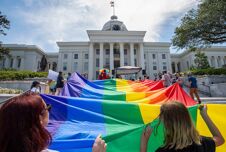At an official state luncheon held at the White House, President Joe Biden and First Lady Jill Biden welcomed Australian Prime Minister Anthony Albanese and his partner Jodie Hayden.
During the visit, reports surfaced of a deranged shooter toting an AR-style military rifle bursting into a bowling ally on what was billed as “youth night” and then driving to a local restaurant and bar, all in the small city of Lewiston, Maine. Though the total number of casualties was initially uncertain, it was clear that at least 18 people had been savagely murdered with several more injured, some in critical condition.
Related:
Suspected Maine mass shooter made anti-trans posts on social media
He re-tweeted messages about “trans/non-binary mass shooters” and another opposing a ban on assault weapons.
President Biden and Vice President Harris took time from their prepared remarks with Prime Minister Albanese to talk about the tragic events in Lewiston.
Dive deeper every day
Join our newsletter for thought-provoking commentary that goes beyond the surface of LGBTQ+ issues
“And it’s good to be with so many friends,” said the President, “especially in the midst of tremendous pain and loss at home as well as around the world.
“Our hearts are, of course, with loved ones of people who were killed in the horrific shooting last night in Lewiston, Maine, along with the many who are injured. We wish them the speediest of recoveries.”
Vice President Harris added: “Last night, Lewiston became yet another community torn apart by senseless gun violence. Once again, routine gatherings — this time at a bowling alley and a restaurant — have been turned into scenes of horrific carnage. Doug and I mourn for those who were killed…”
She assured those assembled that “the Biden-Harris administration will continue to provide full support to local authorities. And as we gather details, we must continue to speak truth about the moment we are in.”
Harris reiterated the tragic fact that gun violence is the leading cause of death of children in the United States.
“Gun violence has terrorized and traumatized so many of our communities in this country. And let us be clear, it does not have to be this way, as our friends in Australia have demonstrated.”
It seems as no mere coincidence, but rather more as a poignant sign, that the Lewiston shooting spree occurred during the Australian Prime Minister and his partner’s visit to these shores. Because in many ways, Australia’s measures serve as a shining beacon in modeling necessary and appropriate actions following the brutal firearms slaughter upon their own shores.
Before and up to 1996, Australia had relatively high rates of murder, but a tragic incident at Port Arthur, Tasmania on April 28, 1996, was the proverbial straw that broke the poor camel’s back. On that date, a man opened fire on a group of tourists, killing 35 and wounding another 23. The massacre was the worst mass murder in Australia’s history.
Taking decisive action, newly-elected conservative Prime Minister John Howard negotiated a bipartisan deal between the national, state, and local governments in enacting comprehensive gun safety measures, which included a massive buyback of more than 600,000 semi-automatic rifles and shotguns and laws prohibiting private firearms sales, establishing mandatory registration by owners of all weapons, and requiring that all potential gun buyers at the time of purchase give a “genuine reason” other than general or overarching self-defense without documentation of necessity.
By 1996, polls showed overwhelming public support, approximately 90%, for the new measures. And though firearms-related injuries and death have not totally come to an end, according to the Washington Post, homicides by firearms fell by 59% between 1995 and 2006 with no corresponding increase in non-firearm-related homicides, as well as a 65% reduction in gun-related suicides.
Other studies found significant drops in robberies involving firearms, and contrary to fears by some, no increase in the overall number of home invasions. In the decade preceding the Port Arthur massacre, Australia recorded 11 mass shootings. No mass shootings have occurred since the measures went into effect.
Just six days after the terrible hate-inspired gun murders of Muslims praying at two Mosques in Christchurch, New Zealand, Prime Minister Jacinda Ardern announced sweeping new firearms regulations, which included banning semi-automatic rifles and large-capacity ammunition magazines, as well as a mandatory government buyback of such previously sold weapons.
The U.S. Congress enacted a brief federal ban on assault weapons, The Public Safety and Recreational Firearms Use Protection Act, in September 1994. The ban, which also included barring high-capacity magazines, expired in September 2004 as required in its 10-year sunset provision. Congress has not since reauthorized the measure.
As a provision inserted as a rider into the 1996 federal government omnibus spending bill, the Dickey Amendment (named after Arkansas Republican Representative Jay Dickey who was lobbied heavily by the National Rifle Association) passed into law. It mandated that “none of the funds made available for injury prevention and control at the Centers for Disease Control and Prevention (CDC) may be used to advocate or promote gun control.”
At a press conference following the Maine shooting spree, Congressman Jared Golden (D), representing Lewiston and Maine’s second district, changed his previous position by calling on Congress to ban assault rifles.
“I propose that we should ban deadly weapons of war like the assault rifle used to carry out this crime,” he argued. “The time has now come for me to take responsibility for this failure, which is why I now call on the United States Congress to ban assault rifles like the one used by this sick perpetrator of this mass killing.”
In a rather emotional plea, Golden asked forgiveness from his community for not taking decisive action previously in advocating for gun safety reforms.
So, what limits, on the national, state, and local levels should we as a nation consider and enact on the sale and ownership of firearms? Many people within the larger gun safety movement have proposed “common sense” solutions. Unfortunately, what one person determines as “common sense,” another person considers as “freedom killing.”
How free, though, are any of us as an estimated 11,000+ people are murdered annually, and another 22,000+ lose their lives by guns through accident or suicide? How free are we as the guns lobby purchases our politicians in the service of firearms manufacturers in their quest to acquire even more power and profits?
With the relatively easy access to firearms in the United States, few of us have not already been touched by the ravages of gun violence. Hardly a day goes by that we don’t hear of yet another high-visibility mass shooting, which does not even begin to reflect the seemingly countless number of lives taken in small towns and large cities throughout the nation that don’t make it to the national spotlight.
The Lewiston murders comprised the 566th mass shooting in the United States in 2023.
What will it take for us to cease fighting insanity with insanity? How many more of our precious people of all ages will have their lives cut short under the banner of “freedom to bear arms”?
What will it take for us to reverse the unholy alliance between corporate America and powerful pressure groups controlling politicians in the service of firearms manufacturers?
When is enough, enough?
—
















What will it take for us to stop fighting insanity with insanity?